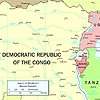
Beginning on April 6, 1994, and for the next hundred days, up to 800,000 Tutsis were killed by Hutu militia using clubs and machetes, with as many as 10,000 killed each day.
Rwanda is one of the smallest countries in Central Africa, with just 7 million people, and is comprised of two main ethnic groups, the Hutu and the Tutsi. Although the Hutus account for 90 percent of the population, in the past, the Tutsi minority was considered the aristocracy of Rwanda and dominated Hutu peasants for decades, especially while Rwanda was under Belgian colonial rule.
Following independence from Belgium in 1962, the Hutu majority seized power and reversed the roles, oppressing the Tutsis through systematic discrimination and acts of violence. As a result, over 200,000 Tutsis fled to neighboring countries and formed a rebel guerrilla army, the Rwandan Patriotic Front.
In 1990, this rebel army invaded Rwanda and forced Hutu President Juvenal Habyalimana into signing an accord which mandated that the Hutus and Tutsis would share power.
Ethnic tensions in Rwanda were significantly heightened in October 1993 upon the assassination of Melchior Ndadaye, the first popularly elected Hutu president of neighboring Burundi.
A United Nations peacekeeping force of 2,500 multinational soldiers was then dispatched to Rwanda to preserve the fragile cease-fire between the Hutu government and the Tutsi rebels. Peace was threatened by Hutu extremists who were violently opposed to sharing any power with the Tutsis. Among these extremists were those who desired nothing less than the actual extermination of the Tutsis. It was later revealed they had even drawn up lists of prominent Tutsis and moderate Hutu politicians to kill, should the opportunity arise.
In April 1994, amid ever-increasing prospects of violence, Rwandan President Habyalimana and Burundi's new President, Cyprien Ntaryamira, held several peace meetings with Tutsi rebels. On April 6, while returning from a meeting in Tanzania, a small jet carrying the two presidents was shot down by ground-fired missiles as it approached Rwanda's airport at Kigali. Immediately after their deaths, Rwanda plunged into political violence as Hutu extremists began targeting prominent opposition figures who were on their death-lists, including moderate Hutu politicians and Tutsi leaders.
The killings then spread throughout the countryside as Hutu militia, armed with machetes, clubs, guns and grenades, began indiscriminately killing Tutsi civilians. All individuals in Rwanda carried identification cards specifying their ethnic background, a practice left over from colonial days. These 'tribal cards' now meant the difference between life and death.
Amid the onslaught, the small U.N. peacekeeping force was overwhelmed as terrified Tutsi families and moderate politicians sought protection.
Among the peacekeepers were ten soldiers from Belgium who were captured by the Hutus, tortured and murdered. As a result, the United States, France, Belgium, and Italy all began evacuating their own personnel from Rwanda.
However, no effort was made to evacuate Tutsi civilians or Hutu moderates. Instead, they were left behind entirely at the mercy of the avenging Hutu.
Back at U.N headquarters in New York, the killings were initially categorized as a breakdown in the cease-fire between the Tutsi and Hutu. Throughout the massacre, both the U.N. and the U.S. carefully refrained from labeling the killings as genocide, which would have necessitated some kind of emergency intervention.
On April 21, the Red Cross estimated that hundreds of thousands of Tutsi had already been massacred since April 6 - an extraordinary rate of killing.
The U.N. Security Council responded to the worsening crisis by voting unanimously to abandon Rwanda. The remainder of U.N. peacekeeping troops were pulled out, leaving behind a only tiny force of about 200 soldiers for the entire country.
The Hutu, now without opposition from the world community, engaged in genocidal mania, clubbing and hacking to death defenseless Tutsi families with machetes everywhere they were found. The Rwandan state radio, controlled by Hutu extremists, further encouraged the killings by broadcasting non-stop hate propaganda and even pinpointed the locations of Tutsis in hiding. The killers were aided by members of the Hutu professional class including journalists, doctors and educators, along with unemployed Hutu youths and peasants who killed Tutsis just to steal their property.
Many Tutsis took refuge in churches and mission compounds. These places became the scenes of some of the worst massacres. In one case, at Musha, 1,200 Tutsis who had sought refuge were killed beginning at 8 a.m. lasting until the evening. Hospitals also became prime targets as wounded survivors were sought out then killed.
In some local villages, militiamen forced Hutus to kill their Tutsi neighbors or face a death sentence for themselves and their entire families. They also forced Tutsis to kill members of their own families.
By mid May, an estimated 500,000 Tutsis had been slaughtered. Bodies were now commonly seen floating down the Kigara River into Lake Victoria.
Confronted with international TV news reports depicting genocide, the U.N. Security Council voted to send up to 5,000 soldiers to Rwanda. However, the Security Council failed to establish any timetable and thus never sent the troops in time to stop the massacre.
The killings only ended after armed Tutsi rebels, invading from neighboring countries, managed to defeat the Hutus and halt the genocide in July 1994. By then, over one-tenth of the population, an estimated 800,000 persons, had been killed.
Copyright © 1999 The History Place™ All Rights Reserved
![]()
- NEXT SECTION - Pol Pot in Cambodia: 1975-1979
- Genocide Index Page
- The History Place Main Page
- U.N. International Criminal Tribunal for Rwanda
Terms of use: Private home/school non-commercial, non-Internet re-usage only is allowed of any text, graphics, photos, audio clips, other electronic files or materials from The History Place.
